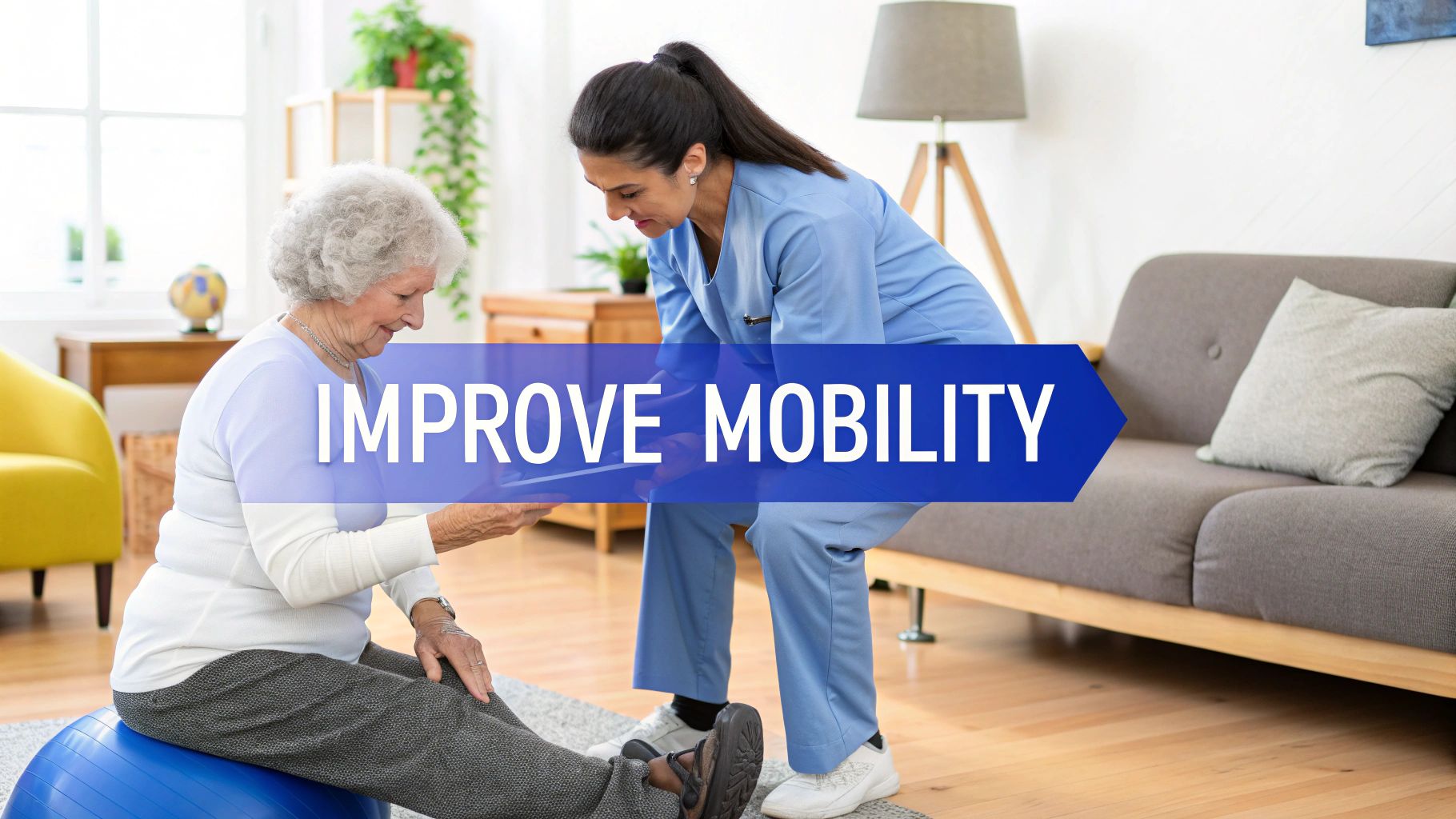The Power of Healing at Home: Why Senior PT Is Transforming Care
For many seniors, the thought of traditional physical therapy can be daunting. Traveling to a clinic, navigating unfamiliar equipment, and managing the logistics can be a significant obstacle. In-home physical therapy for seniors presents a valuable alternative. By bringing therapy directly into the senior's home, this approach tackles many of the barriers that can hinder progress and overall well-being.
This shift in care creates a more comfortable and personalized experience. In the familiar environment of their own home, seniors are often more relaxed and at ease. This can lead to greater engagement in therapy sessions and improved outcomes. In addition, in-home physical therapy removes the stress and difficulty associated with transportation, making it a more accessible option for seniors with mobility limitations. You might be interested in: How to master in-home senior care.
Personalized Care in Familiar Surroundings
The personalized aspect of in-home physical therapy is a major benefit. Therapists can tailor exercises and treatment plans to the individual's specific needs and objectives, considering their living environment.
For example, a therapist might integrate the use of a favorite chair or staircase into the exercise routine. This makes the therapy more functional and relevant to daily life. This level of customization is often difficult to replicate in a traditional clinic.
Furthermore, in-home physical therapy offers therapists important insights into a senior's daily living challenges. By observing the home environment, therapists can pinpoint potential hazards. They can then make recommendations for modifications to enhance safety and accessibility. This could include suggesting grab bars in the bathroom, removing trip hazards, or rearranging furniture to create clearer pathways.
The demand for these services is increasing. Over 50 million Americans seek physical therapy annually, with 55% of those patients being over 65. The global physical therapy market is projected to reach $39.4 billion by 2025, highlighting the growing need for accessible options like in-home care. Find more detailed statistics here.
Improved Outcomes and Reduced Healthcare Costs
In-home physical therapy isn’t simply about convenience; it's about empowering seniors to regain independence and improve their quality of life in the comfort of their homes. By addressing the unique challenges seniors encounter in their daily routines, this approach cultivates a sense of security and encourages active participation in therapy.
This results in better adherence to treatment plans and, consequently, better overall health outcomes. Beyond improving mobility and reducing pain, in-home physical therapy can also be instrumental in preventing falls, a significant concern for older adults. This proactive approach can contribute to lower healthcare costs associated with fall-related injuries.
Why Your Living Room Beats The Clinic: Senior PT Benefits
In-home physical therapy offers unique advantages for seniors compared to traditional clinic-based therapy. The familiar home setting reduces anxiety and cognitive strain, allowing older adults to focus on their exercises without the distractions of a new environment. This improved concentration can lead to more effective sessions and faster progress. The comfort and security of home are especially beneficial for seniors with dementia or other cognitive challenges.
Comfort and Convenience: Reducing Barriers to Success
Imagine trying to exercise while feeling anxious or disoriented. For many seniors, this can be the experience of going to a busy clinic. In-home physical therapy eliminates this stress. By holding sessions in the comfort of their living room, seniors can concentrate on improving their mobility and strength. It also removes the obstacle of transportation, which can be significant. For example, one study showed that removing transportation barriers increased consistent therapy participation by 70%. This consistency is key to achieving long-term health improvements.
Personalized Approaches and Family Involvement
In-home physical therapy allows for highly personalized treatment. Therapists can evaluate the senior's home and incorporate everyday objects into the exercises. This practical approach connects therapy to daily life, making it more likely that seniors will continue exercises independently and achieve greater long-term success. Family members can also participate more easily in home sessions. This builds a supportive environment and helps seniors maintain their exercises between therapist visits.
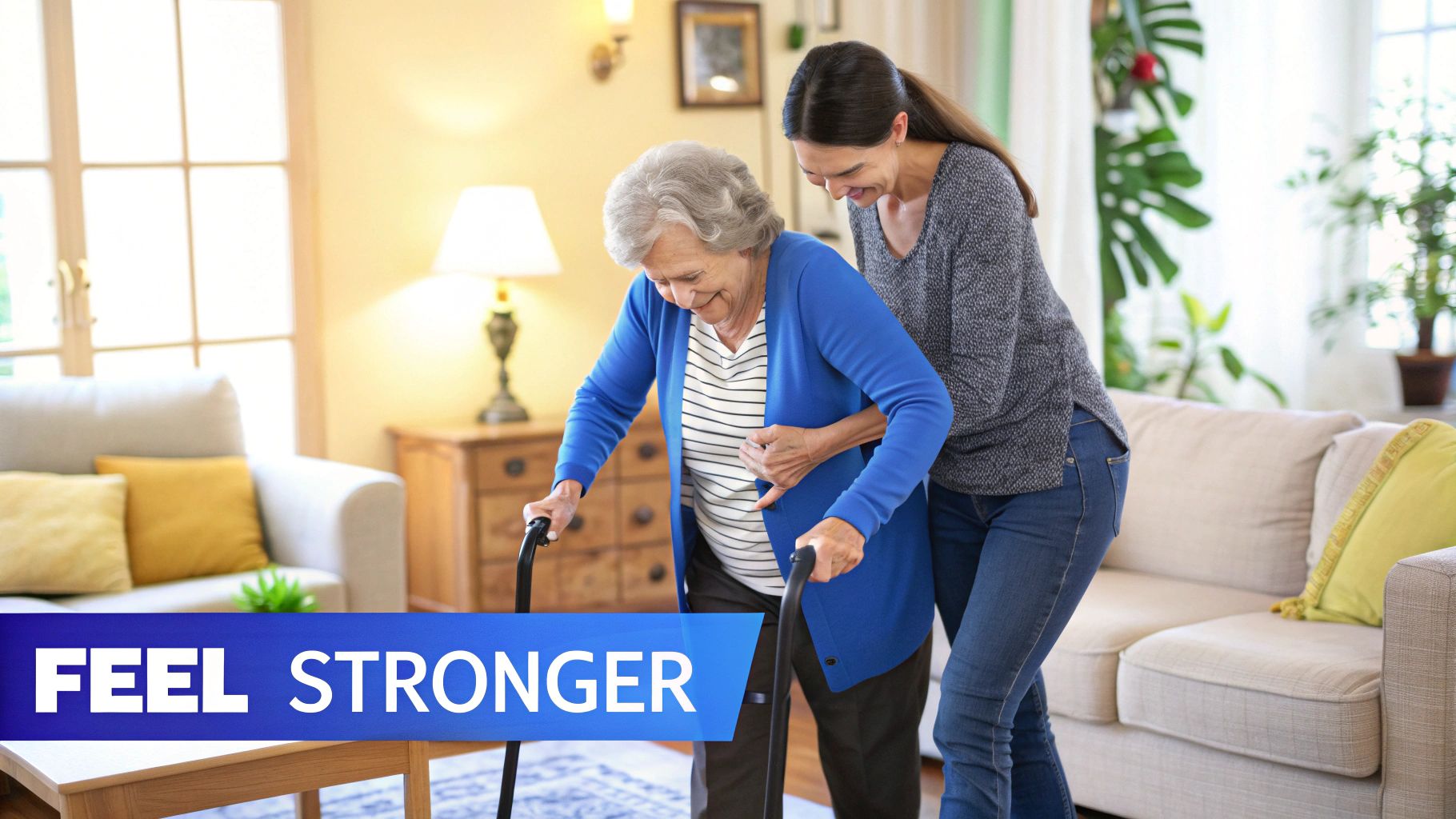
Addressing the Global Need for Accessible Rehabilitation
Worldwide, the need for rehabilitation is growing due to an aging population and a rise in chronic conditions. The World Health Organization estimates that approximately 2.4 billion people globally have conditions that could benefit from rehabilitation. In-home physical therapy provides a vital solution, particularly for seniors facing access challenges to traditional healthcare. Falls, for example, are a leading cause of injury-related deaths among older adults. Physical therapy can reduce fall risk by 25%, highlighting its power to improve outcomes and reduce healthcare costs by providing accessible care directly to seniors. Learn more here. As the global population ages, innovative care models like in-home physical therapy are becoming increasingly important for maintaining mobility and independence for seniors.
Reclaiming Independence: Conditions Home PT Transforms
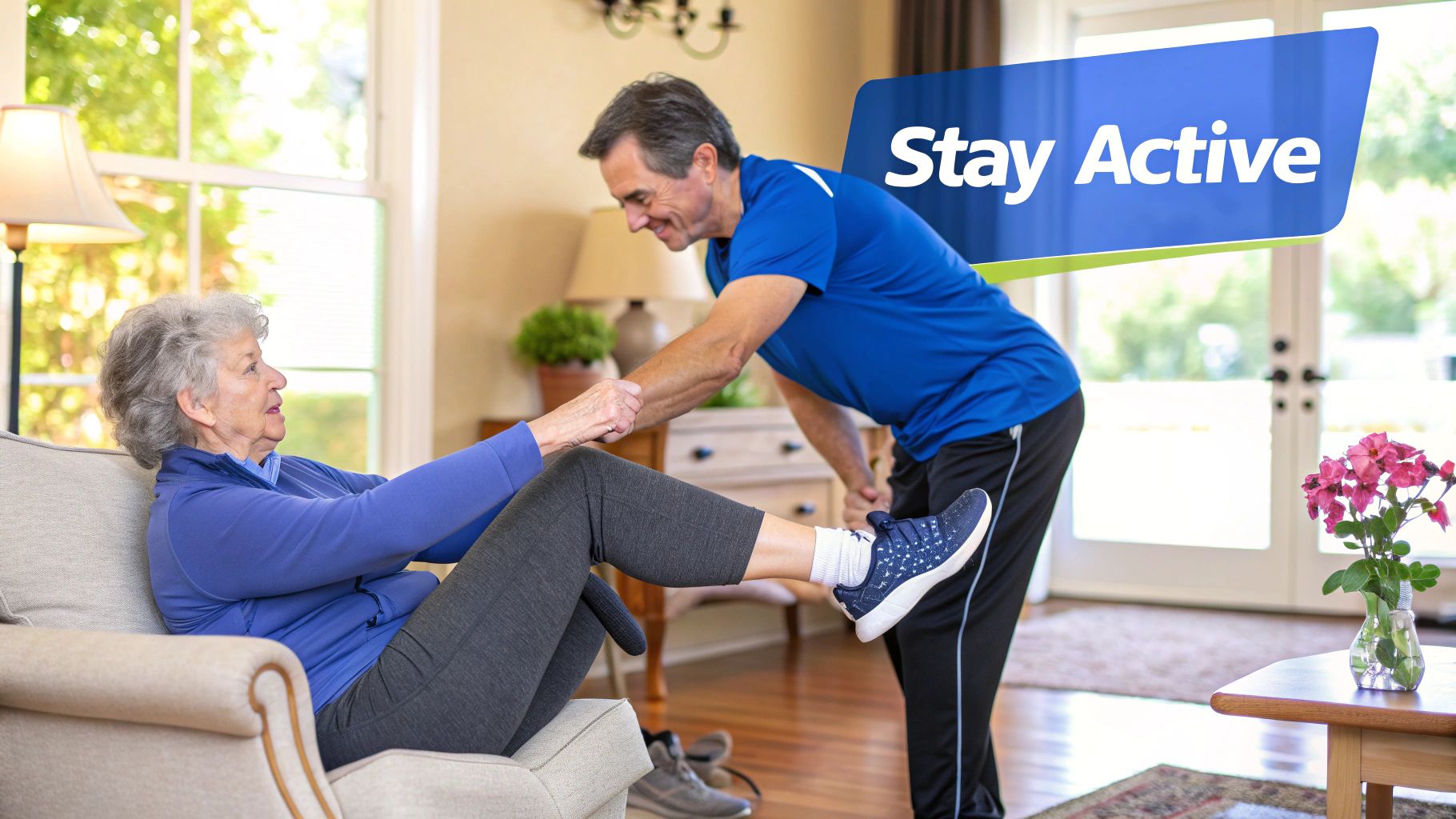
In-home physical therapy offers seniors a unique opportunity to regain independence and improve their quality of life. It's more than just basic mobility exercises; it's a personalized approach to care within the comfort of a senior's own home. This familiar environment allows for practical application of therapeutic techniques, making the recovery process more effective and empowering.
Targeted Treatments For Specific Conditions
In-home physical therapy addresses a wide spectrum of conditions. From post-surgical rehabilitation to managing chronic illnesses, therapists tailor treatments to individual needs and circumstances. For example, after a joint replacement, therapists can guide seniors through exercises using their own furniture, promoting real-world functionality.
This personalized approach also benefits seniors recovering from cardiac procedures. Therapists carefully monitor activity levels, ensuring a safe and gradual increase in exertion within the home environment. Furthermore, in-home physical therapy provides specialized care for neurological conditions like Parkinson's disease, helping manage tremors and improve motor skills. It also addresses chronic pain associated with arthritis and supports recovery after a stroke.
To illustrate the range of conditions typically addressed with in-home physical therapy, let's look at the following table:
Common Conditions Treated With In-Home Physical Therapy
| Condition | Treatment Approaches | Expected Outcomes | Average Treatment Duration |
|---|---|---|---|
| Post-Surgical Recovery (Joint Replacement) | Guided exercises, mobility training, pain management | Improved strength, range of motion, functional mobility | 6-8 weeks |
| Cardiac Rehabilitation | Graded exercise programs, monitoring vital signs, education on lifestyle modifications | Increased endurance, improved cardiovascular health | 8-12 weeks |
| Parkinson's Disease | Balance training, gait training, exercises to improve motor control | Reduced tremors, improved mobility and stability | Ongoing, as needed |
| Arthritis | Range of motion exercises, pain management techniques, strengthening exercises | Reduced pain, improved joint function | Ongoing, as needed |
| Stroke Recovery | Exercises to improve motor skills, speech therapy, cognitive exercises | Improved function, independence, and quality of life | Varies depending on severity |
This table highlights the tailored nature of in-home physical therapy and the positive impact it can have on various health conditions. The average treatment duration varies based on the individual's specific needs and progress.
Fall Prevention: A Focus On Safety and Stability
Fall prevention is a crucial aspect of in-home physical therapy for seniors. Therapists conduct thorough home assessments to identify potential hazards. This includes evaluating lighting, flooring, and furniture placement. They then create personalized fall prevention programs incorporating exercises to improve balance and strength.
Recommendations might include removing tripping hazards, improving lighting, and installing grab bars in the bathroom. These modifications, combined with targeted exercises, can significantly reduce fall risks by as much as 40%. This proactive approach helps seniors maintain their independence and avoid debilitating injuries.
Comprehensive Care Through Collaboration
In-home physical therapists often collaborate with other healthcare professionals, such as physicians, nurses, and occupational therapists. This interdisciplinary approach ensures comprehensive and coordinated care, addressing the senior's overall well-being. Home care for the Elderly often plays a crucial role in this integrated care model. By working together, these professionals empower seniors to achieve their health goals and live more fulfilling lives.
Recent research emphasizes the benefits of high-intensity home health physical therapy, particularly for seniors experiencing hospital-associated deconditioning or managing multiple health conditions. Studies indicate that both high-intensity and standard physical therapy interventions are effective in improving physical function, notably gait speed and overall performance. These improvements directly contribute to fall prevention and enhanced quality of life. Learn more about these findings here. With the global aging population steadily increasing, home-based physical therapy offers a valuable, accessible, and cost-effective solution for improving senior health.
Inside a Senior PT Session: What Really Happens at Home
Wondering what an in-home physical therapy session looks like? Let's explore the process, from the initial evaluation to the concluding visit.
The Initial Assessment: Understanding Individual Needs
The first visit is all about assessment. The physical therapist evaluates the senior's physical abilities and assesses their living environment. This crucial step helps the therapist understand the individual's needs and how their home can best support their therapy. This also involves pinpointing potential safety hazards and suggesting modifications.
Adapting Clinical Techniques for the Home
Physical therapists are experts at adapting standard clinical practices to the home. Everyday furniture, such as chairs and sofas, is incorporated into the exercises. This functional approach makes therapy more relevant to daily life. For example, a therapist might use a dining chair for sit-to-stand exercises, strengthening muscles used for everyday tasks.
Measuring Progress: Focusing on Functional Improvement
Progress is tracked using practical, real-life metrics. Rather than focusing solely on range of motion, therapists observe how well a senior performs activities like getting out of bed or walking to the kitchen. This emphasis on functional improvement gives seniors tangible progress they can see, boosting motivation and confidence.
Building Independence: A Gradual Approach
Treatment intensity changes over time to promote independence. Initially, the therapist might provide hands-on assistance. As the senior gains strength and mobility, the therapist gradually decreases assistance, empowering them to perform tasks independently. Home PT can help seniors regain independence, which can sometimes be emotionally challenging; for additional support, explore resources like becoming more resilient.
Equipment and Family Involvement: Practical and Supportive
Therapists may use specialized equipment, but they are also skilled at repurposing household items. This practicality makes the exercises more sustainable long-term. Family involvement is encouraged, with therapists providing guidance on appropriate support levels. This ensures the senior remains the active participant in their recovery.
The Emotional Component: Healing in a Familiar Setting
In-home physical therapy offers emotional benefits. The familiar home setting reduces anxiety and allows seniors to focus on healing. The one-on-one attention and support from the therapist rebuilds confidence, not just physical strength. This personalized approach fosters a strong therapeutic relationship, contributing to a positive rehabilitation experience.
Creating Your Home Healing Zone: Setting Up for Success
Your home environment plays a crucial role in your physical therapy journey. This section offers practical, room-by-room advice to optimize your home for healing and maximize the effectiveness of in-home physical therapy for seniors. These simple adjustments can create a safe and supportive recovery space without expensive renovations.
Simple Changes, Big Impact: Optimizing Your Space
Begin by decluttering and rearranging furniture to establish clear pathways. These safe exercise pathways are crucial for comfortable, safe movement during therapy sessions. Improved lighting can also significantly reduce fall risks by as much as 30%. Consider adding brighter bulbs or nightlights, particularly in hallways and bathrooms. Simple surface modifications can also make a big difference in stability. For instance, secure loose rugs with non-slip mats or remove them entirely.
- Clear pathways: Remove clutter and rearrange furniture to create wide, unobstructed walkways.
- Enhanced lighting: Increase brightness in all areas, especially high-traffic zones, to improve visibility.
- Secure surfaces: Use non-slip mats under rugs, or remove rugs altogether, to minimize fall hazards.
Essential Equipment and Adaptive Tools
While specialized adaptive equipment might be required in some cases, many everyday household items can be repurposed. A sturdy chair, for example, can be used for certain exercises. However, some investments are well worth the cost. A raised toilet seat and grab bars can significantly improve bathroom safety. We'll explore both budget-friendly and higher-end options.
| Item | Benefit | Price Range |
|---|---|---|
| Raised Toilet Seat | Easier transitions | $20 – $100 |
| Grab Bars | Improved stability | $15 – $50 |
| Reacher/Grabber | Accessing items safely | $10 – $30 |
Dedicated Therapy Zones and Bathroom Modifications
Creating a dedicated therapy zone encourages regular practice between scheduled sessions. This area could be a corner of the living room or a spare bedroom. Make the space inviting and well-lit, equipped with all necessary items. Optimizing bathroom safety is paramount for senior independence. Simple additions like grab bars, non-slip mats, and a shower chair can dramatically improve this space without making it feel clinical.
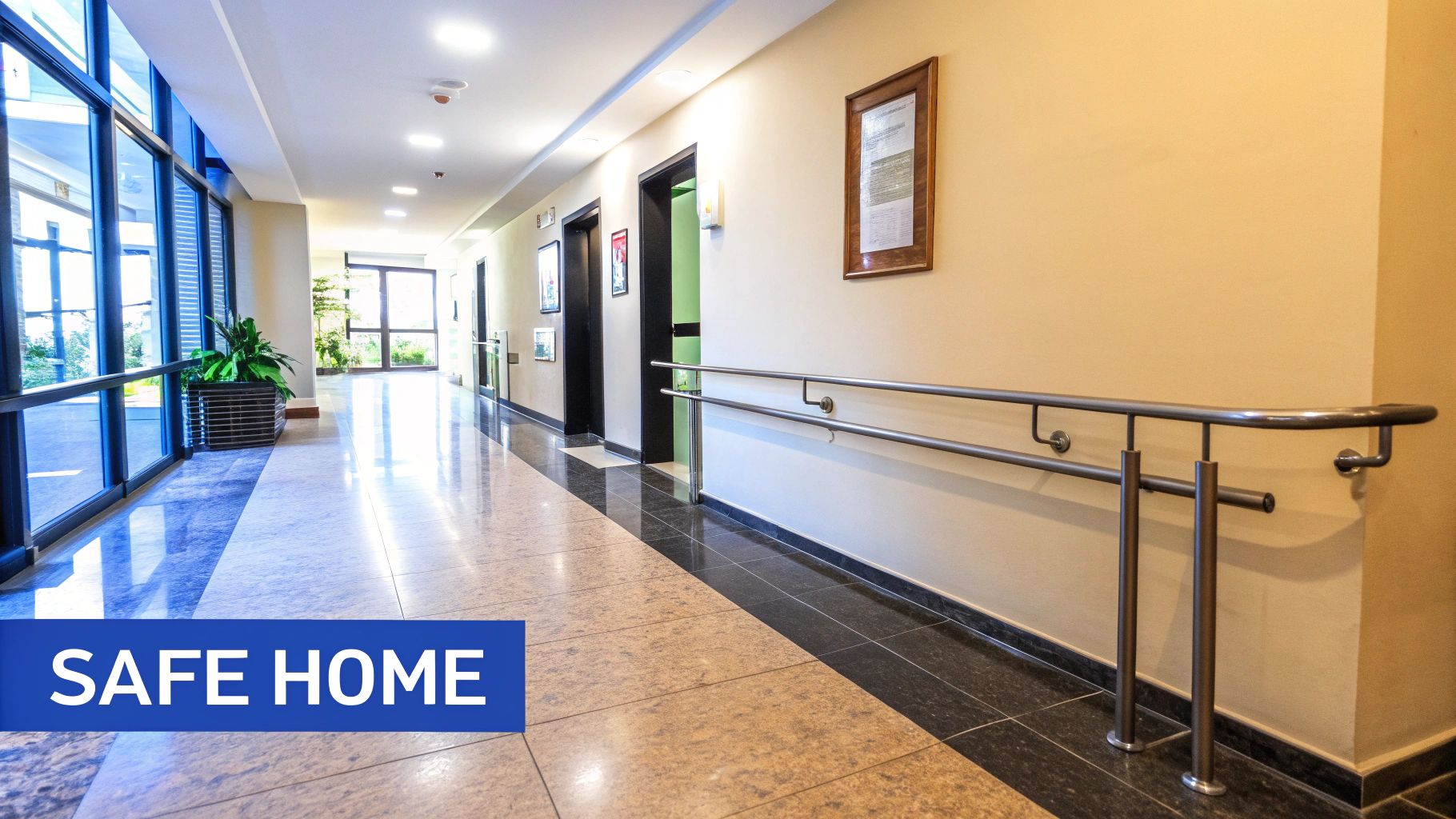
Kitchen Modifications for Rehabilitation and Independence
The kitchen can also be adapted to support therapy and daily living. Adjusting countertop heights or installing pull-out shelves can simplify meal preparation. These modifications not only aid rehabilitation but also promote long-term independence. The ultimate goal is to create a supportive environment that encourages both recovery and a sense of autonomy.
Finding Your Perfect PT Match: Beyond Basic Credentials
Choosing the right physical therapist for a senior loved one can feel overwhelming. This guide helps you navigate the process, from understanding essential certifications to asking the right questions. We'll also cover insurance coverage and how to ensure a smooth, effective therapy experience.
Decoding Credentials and Certifications
A valid physical therapy license is a must, but specialized certifications indicate a deeper understanding of senior care. For example, the Geriatric Clinical Specialist (GCS) designation signifies advanced knowledge in the unique needs of older adults. Medicare coverage can be complex, so understanding what’s covered – and what providers say is covered – is crucial for avoiding unexpected costs. For more guidance on finding senior care, check out this helpful resource: How to find caregivers for the elderly.
Creating a comfortable therapy space at home is also important. Consider these home office setup ideas for inspiration on creating a calm and organized environment conducive to healing.
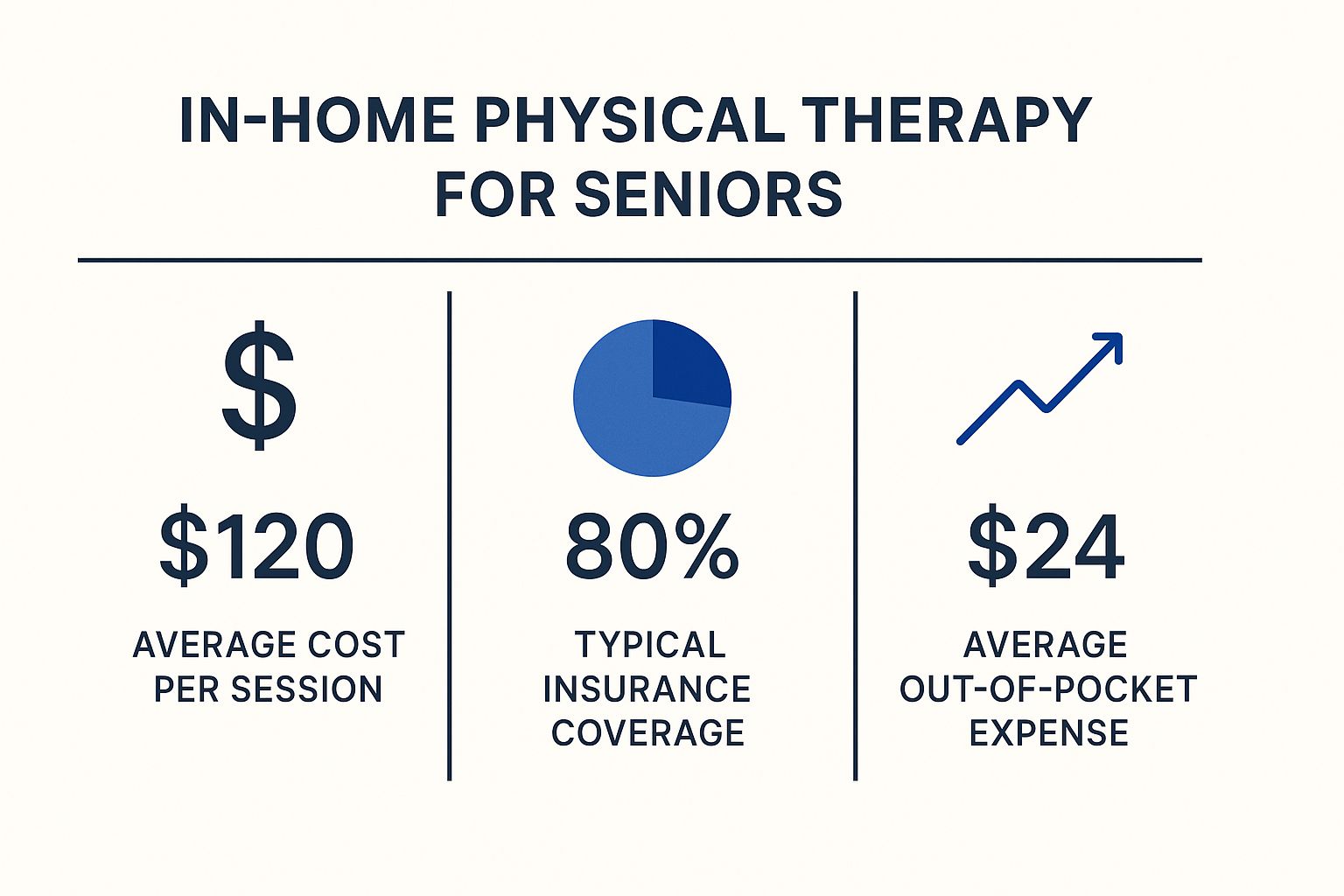
This infographic breaks down the costs associated with in-home physical therapy for seniors. It shows the average cost per session, typical insurance coverage, and estimated out-of-pocket expenses. While the per-session cost might seem high initially, insurance often covers a significant portion, making in-home therapy a financially viable option for many.
To help you compare in-home and outpatient options, we've created a comparison table outlining the key differences:
Comparing In-Home vs. Outpatient Physical Therapy for Seniors
This comparison table highlights the key differences between in-home and outpatient physical therapy options for seniors to help families make informed decisions
| Factor | In-Home Physical Therapy | Outpatient Physical Therapy | Best For |
|---|---|---|---|
| Convenience | Therapist comes to the patient's home | Patient travels to a clinic | Individuals with mobility limitations |
| Cost | Typically higher per session | Typically lower per session | Budget-conscious individuals |
| Personalized Attention | One-on-one focus | May involve group sessions or less individual attention | Individuals requiring specialized care |
| Environment | Familiar and comfortable home setting | Clinical setting | Individuals who prefer a structured therapeutic environment |
| Travel | No travel required for the patient | Requires travel to and from appointments | Individuals with transportation challenges |
As you can see, each option offers distinct advantages depending on individual needs and preferences.
Asking the Right Questions: Unveiling Experience and Expertise
Interviewing potential therapists is essential. Asking specific questions can reveal their experience working with seniors. Consider these examples:
- "What is your experience specifically with seniors recovering from (mention specific condition)?"
- "How do you adapt your techniques for patients with cognitive impairments?"
- "Can you describe your approach to fall prevention in the home?"
These questions help assess not only their qualifications but also their communication style and ability to connect with older adults.
Communication, Coordination, and Making a Change
Open communication with the therapy team is vital. Clearly communicate your loved one's needs and preferences. Don't hesitate to ask questions about the treatment plan. Coordination with existing medical providers is also key. Ensure the physical therapist communicates with your loved one’s doctor for a cohesive care approach. Remember, you can always change therapists if the current fit isn't working. Your loved one's comfort and progress are paramount.
Maximizing Coverage and Ensuring Continued Care
Understanding your insurance benefits helps maximize covered sessions. Keep detailed records of each visit, including therapist notes and progress reports. This documentation is crucial for justifying continued care if necessary. Proactive communication with your insurance provider, along with thorough record-keeping, will help ensure your loved one receives the full benefits of their in-home physical therapy program.
Between-Session Success: Keeping Momentum Going
The real impact of in-home physical therapy for seniors happens between scheduled appointments. Consistent practice is the key to significant improvement. This section offers practical tips, gathered from caregivers and seniors who have successfully completed rehabilitation, to help maintain momentum and achieve the best possible results.
Maintaining Motivation and Managing Plateaus
Motivation can fluctuate, especially when progress stalls. This is completely normal. Setting small, achievable goals can make a big difference.
For example, instead of trying to walk a mile, aim for walking to the end of the driveway and back. Gradually increase the distance as strength and mobility improve. Celebrating these small wins reinforces positive feelings and encourages continued effort.
Visual aids can be beneficial for seniors experiencing cognitive decline. A simple calendar with stickers to mark completed exercises, or a whiteboard tracking weekly goals, can provide clear and motivating reminders. Including enjoyable activities can also make exercise feel less like a chore. Listening to favorite music or podcasts while exercising can make the experience more enjoyable.
Safe Assistance and Avoiding Dependency
It's natural to want to help a senior with their exercises, but finding the right balance is crucial. The goal is to encourage independence, not dependence. Focus on encouraging active participation, even if it means slower movements.
Physical therapists can provide guidance on the appropriate level of support for each exercise. This helps caregivers confidently assist without hindering the senior's progress.
Understanding Discomfort and Pain
Learning to differentiate between beneficial therapeutic discomfort and harmful pain is essential. Some muscle soreness after exercise is to be expected. However, sharp or lingering pain should be reported to the therapist right away.
Recognizing these signals is crucial for safe and effective rehabilitation. It allows for timely adjustments to the therapy program, preventing further injury.
Tracking Progress and Adapting Routines
Monitoring progress in meaningful ways contributes to long-term success. While therapists track clinical measurements, personal observations are equally valuable. Notice improvements in daily activities, such as getting dressed or getting in and out of chairs. These real-world accomplishments showcase the practical benefits of therapy and motivate continued effort.
As abilities improve, routines should be adjusted accordingly. Therapists modify exercises to continually challenge the senior, encouraging ongoing progress and avoiding plateaus. This adaptation ensures the therapy program stays effective throughout the rehabilitation process.
Effective Communication and Time Management
Open communication with the senior and the therapist is essential. Discuss any concerns or difficulties openly and honestly. This collaborative approach builds trust and helps resolve any issues that arise.
For caregivers juggling multiple responsibilities, effective time management is vital. Scheduling therapy sessions at convenient times, preparing the exercise area beforehand, and integrating exercises into existing routines can streamline the process. A supportive and organized environment minimizes stress and enhances overall caregiving effectiveness.
Creating Accountability Without Confrontation
Accountability is key for consistent therapy participation. However, it’s important to foster accountability without pressure or conflict. Positive reinforcement and encouragement are much more effective than criticism. Celebrating successes, no matter how small, helps maintain motivation and builds confidence.
This supportive approach empowers seniors to take ownership of their rehabilitation, promoting long-term commitment to the therapy program and achieving lasting results. Printable tracking tools, designed specifically for senior therapy continuity, can also provide a visual reminder of progress and encourage consistent effort.
For compassionate, personalized in-home care that supports senior independence and improves quality of life, consider Caring Hands Senior Services. We serve Mercer County, including Hamilton, Princeton, and the surrounding areas. Learn more about our services and how we can help.

